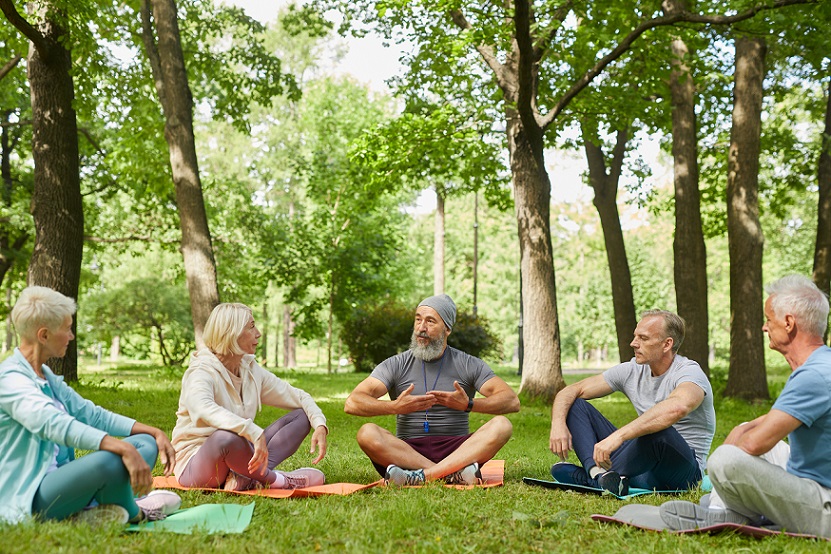Breathing Exercises For Seniors:
Breathing exercises offer a remarkably simple yet powerful method for calming nerves and enhancing mindfulness, especially for seniors. This fundamental, often involuntary act holds the key to relaxation and mental tranquility. Let’s delve into the concept of “breathing exercises for seniors” with a structured approach:
| Breathing Technique | Description | Benefits for Seniors |
|---|---|---|
| Diaphragmatic Breathing | Involves deep breathing using the diaphragm. It’s performed by inhaling deeply through the nose, allowing the abdomen to rise, and then exhaling slowly. | Enhances oxygen flow, reduces stress levels, and promotes relaxation. Ideal for improving lung function and overall vitality. |
| 4-7-8 Breathing | Inhale for 4 seconds, hold the breath for 7 seconds, and exhale for 8 seconds. This technique requires concentration and timing, making it a mindfulness practice. | Aids in sleep quality, reduces anxiety, and helps in managing blood pressure levels. |
| Alternate Nostril Breathing | Involves closing one nostril while inhaling, then closing the other while exhaling. The process is then reversed and repeated. | Balances the left and right hemispheres of the brain, enhances mental clarity, and improves focus. |
| Box Breathing | Also known as square breathing, involves inhaling, holding, exhaling, and holding the breath, each for an equal count (e.g., 4 seconds each). | Helps in stress management, improves concentration, and fosters a sense of calm. |
| Pursed Lip Breathing | Involves inhaling through the nose and exhaling slowly through pursed lips, as if blowing out a candle. | Particularly beneficial for those with respiratory issues, it helps in controlling breath and improving lung efficiency. |
“Breathing exercises for seniors” isn’t just about enhancing physical health; it’s also a gateway to mental serenity, allowing older adults to navigate the challenges of aging with more ease and mindfulness. By integrating these simple yet effective breathing techniques into daily routines, seniors can experience significant improvements in both their physical and mental well-being.

Consider the natural rhythm of your breath when you’re at ease: it tends to be slow and steady. In contrast, stress often leads to faster, more shallow breathing. Deep breathing exercises are beneficial for everyone, particularly for older adults. The act of deep breathing can serve as a reminder to the body, replicating the sensations associated with a relaxed state.
The efficacy of deep breathing largely stems from the signals it sends to the brain. Essentially, these signals activate areas of the brain linked to the autonomic nervous system, which is responsible for rest, relaxation, and recovery.
Focusing on seniors, specifically, the practice of breathing exercises becomes even more pertinent. These exercises not only aid in managing stress and promoting relaxation but also have the potential to improve overall health and well-being in the older population. Let’s explore further the tailored approaches to breathing exercises for seniors.
While breathing alone may not have huge effects; when you take this movement and make voluntary changes, it may be quite powerful. Learning different breathing exercises for seniors, and controlled breathing may be quite helpful.
As we age, our respiratory function can become more compromised. Namely, due to issues such as respiratory muscle weakness, comorbidities, etc. Muscles that support our breathing like the diaphragm can weaken. That being said, weakened respiratory muscles and/or increased stiffness, can result in more labored breathing and/or shallow breathing. Poor oxygenation can be one of the many culprits to feelings of anxiousness.
Indeed, this is where breathing exercises, can be helpful. Furthermore, it can be done in your home, which is also an advantage.
One study, looked specifically at inspiratory muscle training and yoga breathing exercises. In conclusion, yoga respiratory training was deemed as effective, as well as well-tolerated for frail older adults.
Here are some exercises to help get you started, with a guide!
Seated Belly Breathing Exercise for Seniors
Seated breathing exercises are especially advantageous for seniors, as some may find standing for long periods challenging or experience light-headedness. Among various techniques, “belly” breathing is particularly effective and easy to perform while seated. Here are the steps to practice this exercise:
Steps for Belly Breathing:
- Find a Comfortable Position: Sit comfortably on a chair or the floor, or even lie down in a supine position. Choose the position that feels most comfortable for you.
- Hand Placement: Place one hand on your belly, just below the ribcage and above the navel. This will help you feel the movement of your diaphragm during the exercise.
- Alternate Hand Position: Place your other hand on your chest. This hand should remain relatively still throughout the exercise.
- Inhale Deeply: Inhale slowly and deeply through your nostrils, focusing on making the hand on your belly rise, while keeping the hand on your chest stationary.
- Exhale with Control: Exhale slowly through pursed lips, as if you are whistling. This helps control the flow of air as you breathe out.
- Observe Belly Movement: As you exhale, you should feel the hand on your belly fall or move inward. You can gently press on your abdomen to help expel all the air.
- Repeat the Cycle: Continue this breathing pattern for 10-20 cycles. Pay attention to the rhythmic rise and fall of your belly as you breathe.
This belly breathing exercise is a simple yet effective way for seniors to engage in mindful breathing, promoting relaxation and enhancing lung capacity. It can be easily incorporated into daily routines for improved well-being.
Breathing exercises, like, diaphragmatic breathing is used heavily in practices like transcendental meditation and other forms of meditation.
In fact, it has shown to have positive effects on things like heart rate and blood pressure. Types of deep breathing such as this is known to effect the brain, cardiovascular system, respiratory system and gastrointestinal system, through control of the autonomic nervous system.
Not only can this type of breathing be positive from a physiological perspective, but also from a psychological perspective. Hence, why we include it as a breathing exercise for seniors, specifically.
Thoracic Breathing Exercise for Seniors
Thoracic breathing is an excellent exercise for seniors, particularly for building endurance in the respiratory system and supporting muscle groups. Here’s how to do it:
Steps for Thoracic Breathing:
- Choose Your Position: Begin either seated or standing, whichever is more comfortable for you.
- Hand Placement: Place one hand on your chest/thorax area. This will help you focus on the movement in this part of your body during the exercise.
- Alternate Hand Position: Position your other hand on your abdomen. This hand is to monitor and ensure minimal movement in the belly area.
- Inhale Focusing on Thorax: Inhale slowly and deeply through your nostrils, concentrating on expanding your ribcage rather than your abdomen. Try to direct the air into your chest area.
- Observe Chest Movement: As you inhale, the hand on your chest should rise. The goal is to engage your thoracic region rather than relying on belly movement.
- Minimize Abdominal Movement: Your other hand (over your abdomen) should remain as still as possible to ensure thoracic breathing is being executed correctly.
- Exhale Gently: Let your breath out slowly. Focus on a controlled and smooth exhalation.
- Repeat the Process: Continue this pattern of breathing for 10-20 cycles. Pay attention to the rise and fall of your chest with each breath.
Thoracic breathing helps seniors to specifically engage the muscles of the upper body for breathing, which can be beneficial for improving lung capacity and respiratory efficiency. This exercise is also a great way to promote relaxation and stress relief.
Humming Breathing Exercise for Seniors
Humming breathing, also known as the bee breath, is an effective breathing exercise for seniors. It’s particularly beneficial in reducing the ‘fight or flight’ response, promoting relaxation and calmness. Here’s how to practice it:
Steps for Humming Breathing:
- Find a Comfortable Seat: Begin in a seated position. Ensure your back is upright and your shoulders are relaxed.
- Prepare to Breathe: After fully exhaling, relax your body. Then, slowly and deeply inhale through your nostrils.
- Hum During Exhalation: Once your lungs are filled comfortably, begin to exhale and hum simultaneously. Create a sustained “Mmmmmmmmm…” sound as you breathe out. This vibration is the key element of humming breathing.
- Engage Your Abdomen: Optionally, gently contract your stomach muscles as you exhale, aiding in the expulsion of air.
- Complete the Exhale: Continue humming until all air is released from your lungs.
- Repeat the Cycle: Perform this humming breathing technique for 10-15 cycles. Focus on the soothing sound and sensation of the humming to enhance relaxation.
- Mindfulness and Relaxation: As you do this exercise, pay attention to the calming effect of the humming sound and the rhythm of your breath. This practice helps in achieving a meditative state, reducing stress and anxiety.
Humming breathing is not just a breathing exercise; it’s a sensory experience that combines the benefits of deep breathing with the therapeutic effects of sound. It’s particularly suitable for seniors looking to explore gentle yet effective ways to relax and improve their breathing efficiency.
Final Thoughts
In summary, the breathing exercises outlined above offer older adults an accessible and effective way to enhance their overall well-being. Let’s recap their benefits:
- Promotes Calmness: These exercises are specifically designed to instill a sense of calm, both mentally and physically. By focusing on controlled breathing patterns, seniors can significantly reduce stress and anxiety.
- Improves Focus: Regular practice of these breathing techniques can lead to improved concentration and mental clarity, making daily tasks and activities more manageable and enjoyable.
- Strengthens Respiratory Muscles: These exercises are not just about relaxation; they also play a crucial role in strengthening the muscles involved in breathing. This is especially beneficial for older adults, as it can improve lung function and overall respiratory health.
- Accessible and Adaptable: Each of these exercises can be easily practiced at home, with no special equipment needed. They are adaptable to various fitness and mobility levels, making them suitable for a wide range of seniors.
- Enhances Quality of Life: Beyond the immediate benefits of relaxation and focus, these breathing exercises contribute to a higher quality of life. They offer a simple yet powerful tool for managing the physical and mental challenges that often accompany aging.
Incorporating these breathing exercises into the daily routine of seniors can lead to noticeable improvements in their health and well-being. They serve as a gentle yet effective way to nurture the body and mind, fostering a more peaceful and centered lifestyle.
References:





